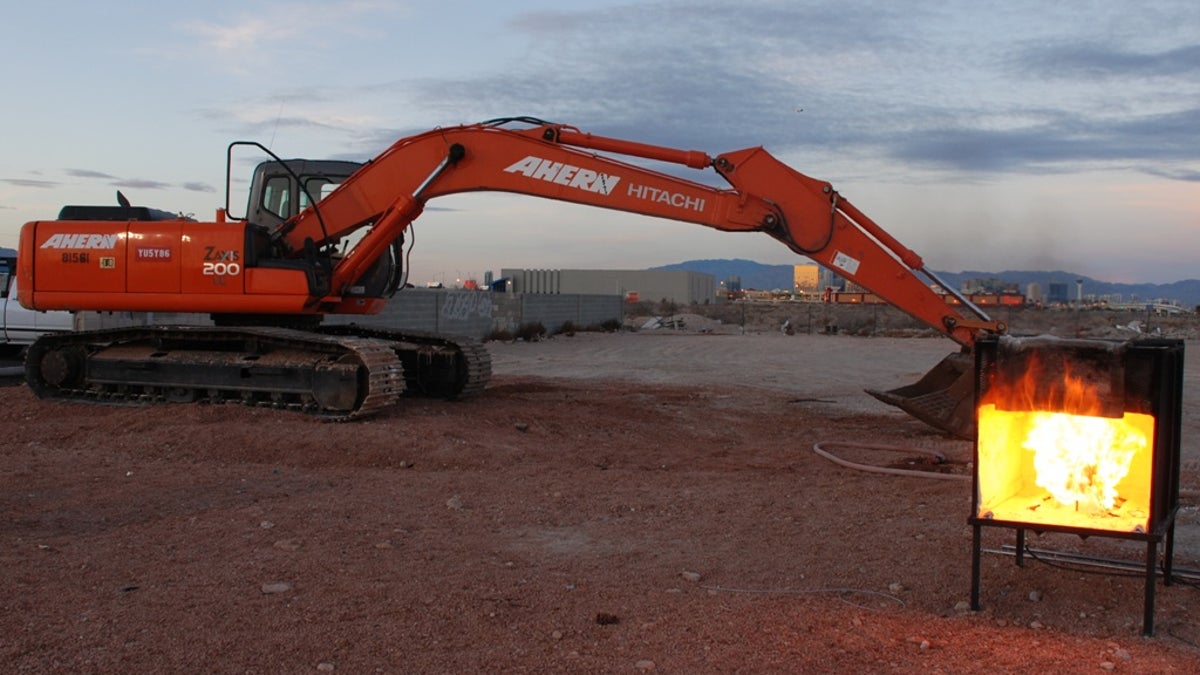IoSafe goes extreme with disaster-proof hard drive
IoSafe performed an elaborate and extreme demo on its new ioSafe Solo SSD external hard drive that's designed to withstand extreme shocks, water, heat, and being crush.

LAS VEGAS--What are the odds that you pour red wine on your laptop causing it to lose data? Quite likely; I've seen it happen. Now, what are the odds that your hard drive gets run over by a 35,000-pound excavator after it has endured heat of thousands of degrees for about 10 minutes and then been hosed down by cold water? Very unlikely, really.
However, that's exactly how far ioSafe, the company that makes disaster-proof storage devices, was willing to go to show how its new Solo SSD external hard drive can withstand even the most destructive circumstances. The company did this in a series of demos at CES 2010, and I was invited to watch.
The ioSafe Solo SSD external hard drive is a external storage device based on the 2.5-inch SATA solid-state drive. However, unlike other 2.5-inch-based external hard drives that are normally very compact and portable, the ioSafe Solo has many layers of protections and is large and heavy, measuring 5 inches by 7.1 inches by 11 inches; it weighs 20 pounds. According to ioSafe, the Solo is the "black box" of data protection that's designed to withstand building collapse, water submergence, extreme crush force, heat, and shock.
The demo, for many obvious reasons, wasn't done at the Las Vegas Convention Center or at any of hotels but out at a construction site in the middle of the desert, a few miles outside of Las Vegas. Robb Moore, ioSafe's CEO, participated in the demo.
First, Moore took a few photos, including one of me, with his digital camera, copying it onto a brand-new Solo SSD external hard drive. The hard drive then was put into a burner for about 10 minutes, which immediately generated fire that burned between 1,400 degrees to 1,500 degrees. An unprotected 3.5-inch hard drive was also put in the burner; it was incinerated in a matter of seconds after the heat was turned on.
After that, the Solo SSD, now with all of its ports and outer layer burned, beyond recognition, was taken out and put in the backhoe of a 35,000-pound excavator and hosed down with cold water to be cooled off. The operator then raised the backhoe up to about 12 feet to 15 feet and the dropped the Solo SSD on the concrete. Now it's time for the last and cruelest part of the demo.
With the Solo SSD now on the ground, the excavator operator slowly drove the machine over the drive. The machine's treads, under the tremendous weight, crushed the Solo SSD's outer protective layer, which kept the drive safe from water and heat, and revealed the ArmorPlate military-grade steel drive casing inside. With the casing, the drive is now about the size of a regular 3.5-inch hard drive. It's this steel casing layer that's supposed to protect the hard drive inside from tremendous crush force.
Moore then opened the steel casing, which took about 5 minutes using a powered screw driver. And inside the Samsung 128GB SSD seemed to be still intact. The question was if the content put on it earlier was also intact.
And it was. Once the drive was connected to the computer via an external hard-drive enclosure, all the photos copied over to it earlier were still there, completely viewable and editable just like nothing had happened.
So the demo was a success. It seems that your data is most protected once put in a ioSafe Solo, unless for some reason the drive's outer layer, designed to protect it from fire and water, was crushed first before it was put into water or fire. But that's an extremely unlikely scenario.
The demo obviously doesn't intend to suggest that something of this extreme nature would happen to your hard drive. However, if disaster strikes, your data has a much better chance of survival. The ioSafe Solo SSD, like other products from ioSafe, is like insurance: you never want to have to use it, but in case you do, you'll be very happy that you have it.
Like insurance, the device is expensive. The ioSafe Solo SSD external hard drive is available now and costs range from $500 (64GB) to $1,249 (256GB). The price includes a recovery service plan where, if disaster strikes, ioSafe will pay up to $5,000 toward the recovery of data for you, if need be.
Moore said the high price of the ioSafe Solo SSD is mostly because of the price of the SSDs. The company is also selling other products, including the ioSafe Solo that the company showed off last CES in a somewhat less extreme demonstration.

